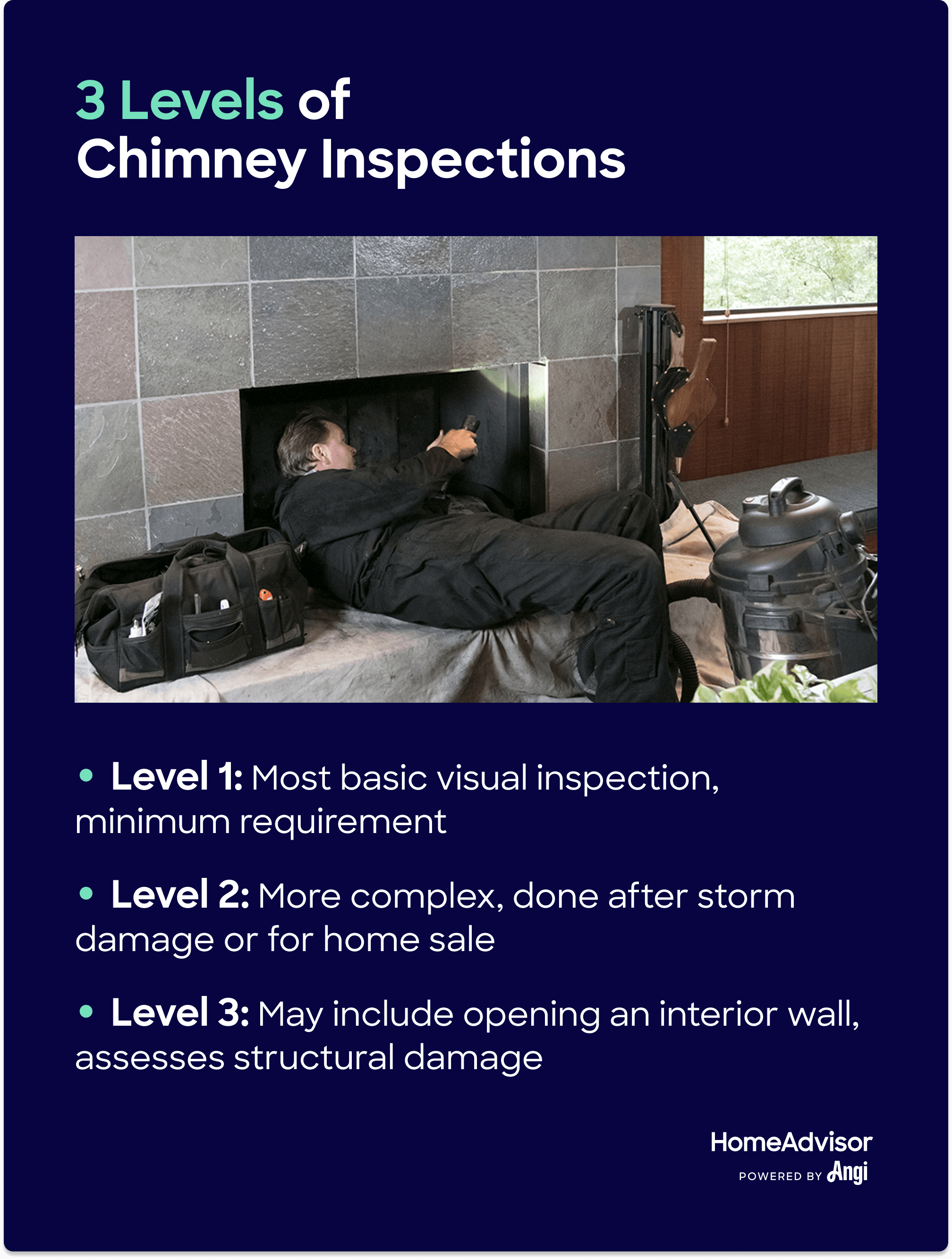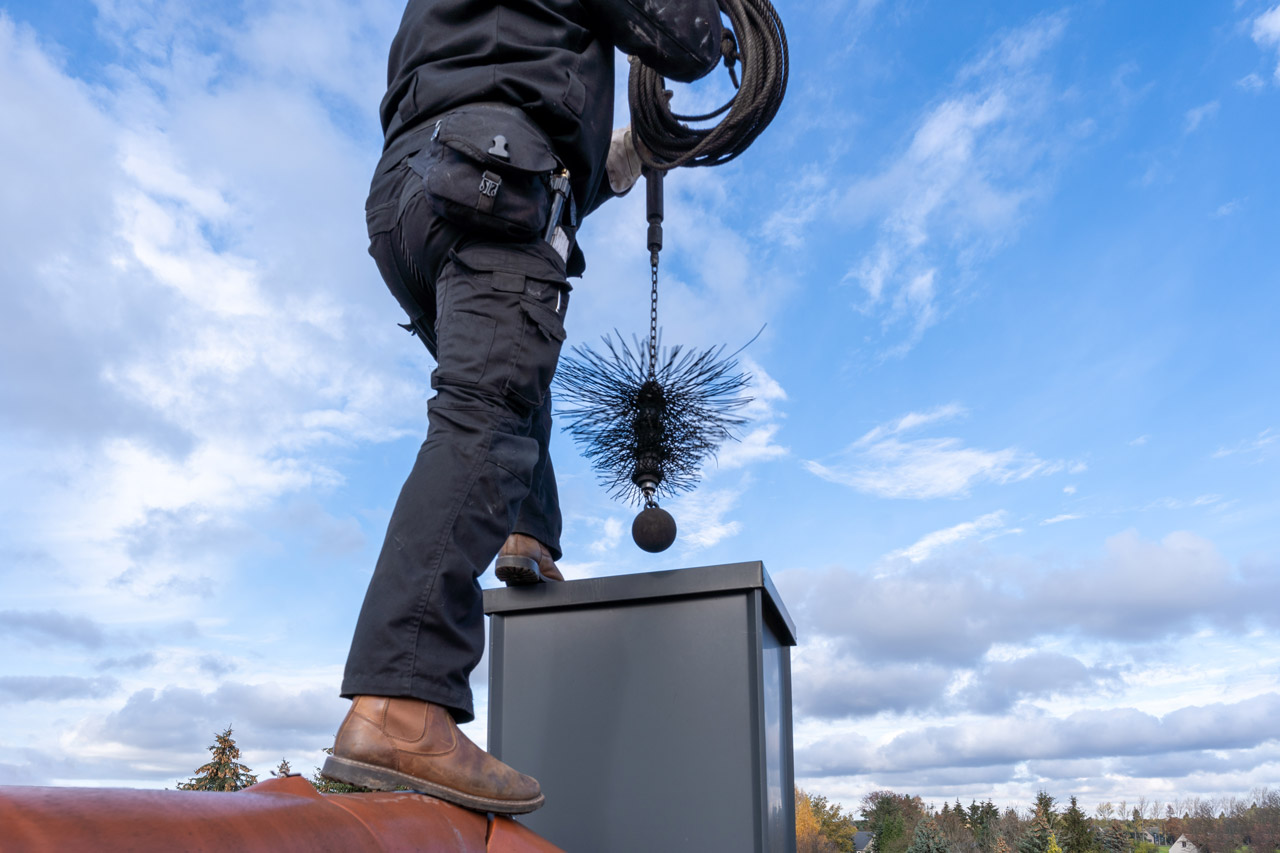How Much Does a Chimney Sweep Cost?
Typical Range:
$129 - $380
Typical Range:
$129 - $380
Cost data is based on actual project costs as reported by 19,323 HomeAdvisor members. Embed this data
.
.
.
.
.
.
.
.
.
.
.
.
.
.
.
.
.
.
.
.
.
.
.
.
.
.
.
.
.
.
•
•
•
•
Updated October 17, 2022
Written by HomeAdvisor.Chimney sweeping has an average cost of $254, with prices typically ranging between $129 and $380. Wood fireplaces that receive regular maintenance price can go for as little as $85 to $100 per cleaning, while those with heavy buildup could total as much as $800.
Let's calculate cost data for you. Where are you located?
Where are you located?
| National Average | $254 |
| Typical Range | $129 - $380 |
| Low End - High End | $89 - $1,000 |
Cost data is based on actual project costs as reported by 19,323 HomeAdvisor members.
Numerous factors and add-on services may affect the cost to sweep your chimney. Below are the main variables that play into your bill.
Installing a chimney cap costs $300 on average, with prices ranging anywhere between $75 and $1,000. A professional is likely to recommend a chimney cap if you have issues with downdrafts—these also help keep debris, water, and animals out of your chimney. Damaged caps should get replaced to ensure efficiency.
During cleaning, you may need to line or reline your chimney for a cost of between $2,500 and $7,000. Flue liners protect the masonry and mortar, extending the life of your chimney. They also retain heat and provide optimal ventilation. If you have a liner that is cracked or damaged, repairs or replacement will make it safer to use your fireplace.
Flashing installation costs $200 to $500 and helps prevent leaks and water damage. You can lower your costs by doing it yourself, but much like other roofing work, it's a good idea to hire a professional to ensure proper installation.
Fireplace dampers cost around $200 to $400 to install and $100 to $225 to repair. Dampers are important for directing smoke up and out of the chimney, as well as for preventing downdrafts.
If your damper is damaged or warped, you'll want to budget for a replacement, as a warped damper could be pulling your indoor air out and decreasing your home's energy efficiency. It may also push smoke into your living space, which could damage your possessions and compromise your safety.
The cost for professional, humane animal removal varies from one species to another, but averages between $200 and $600. Bats, for example, cost more than squirrels to get rid of safely.
Small critters like raccoons tend to make homes out of chimneys, which is unsafe for your home—and for them. It's not uncommon for chimney cleaners to come across small animals and birds, so it’s wise to budget for this factor.
Creosote sweeping logs cost $16 to $25 per log, and convert thick, tar-like creosote buildup into a flaky, more manageable consistency. The creosote then falls like ash onto the hearth of the fireplace.
You can use these logs throughout the year to loosen residue and keep your flue in shape. However, they’re not a replacement for a professional cleaning—be sure to stick to an annual professional cleaning service.
During your cleaning, it's a good idea to invest in the cost for a chimney inspection to check for damage, pests, creosote, and other hazards. If you believe your chimney has damage, it’s a good idea to plan for extra chimney repair costs.
A Level 1 visual inspection typically gets included with your chimney cleaning, while Level 2 inspections can assess major storm damage for an extra $200 to $1,000. Level 3 inspections cost anywhere from $500 to $5,000 and are meant for chimneys with severe structural damage.
If the chimney is difficult or dangerous to access, this could result in additional charges. For example, roofs with a steep pitch are more hazardous to work on, so the pro may charge extra for the job.
Sweeping a chimney with excessive buildup can go as high as $800. Keeping up a regular chimney sweeping schedule means paying less per cleaning.
The method used for chimney sweeping doesn’t have a major impact on cost, but it’s useful to know in order to properly prepare the area. If the cleaner is working from top to bottom, for example, homeowners can seal the hearth and lay tarps for easier cleanup. When getting a quote, ask the pro for recommendations on what to do based on the cleaning method.
While it’s wise to stick to an annual cleaning routine, there are a few key signs that it’s time for a chimney sweep:
Excessive buildup and creosote (wearing a dust mask and safety goggles, you can check this yourself by shining a flashlight and scraping the soot—it should be no more than 1/8 inch thick)
Smoke entering your living space while the fireplace is in use
A rich tar smell emanating out of your fireplace (a sign of creosote buildup)
A fire that’s weaker than usual
Chimney sweeping has many benefits for both safety and efficiency. These include:
Preventing chimney fires
Improving airflow and preventing carbon monoxide poisoning
Burning wood and heating your home more efficiently
Keeping smoke out of your living space, which can compromise the health of your family and damage your furnishings
While DIY chimney sweeping kits are available for around $70 to $120, the extra skill (not to mention effort and mess) required makes hiring a pro well worth the cost. Chimney sweeping is important for ensuring the safety of your chimney and fireplace—enlisting the help of a local chimney sweeper will ensure the job gets done right.
For chimneys that get used regularly, you should sweep once per year. For chimneys that get used more than four or five times per week, consider sweeping more frequently. If the fireplace isn’t used very often, you may be able to extend the time period between cleanings.
The chimney sweeper will clean the chimney of debris and buildup, as well as perform a visual inspection to spot signs of damage. They will start either inside or up on the roof, or they may approach it from both points. Deeper cleans may involve the use of chemicals to remove creosote buildup.
A basic cleaning, which involves a sweep and a visual inspection, typically lasts one to two hours. Deeper cleans may last three hours or more.

